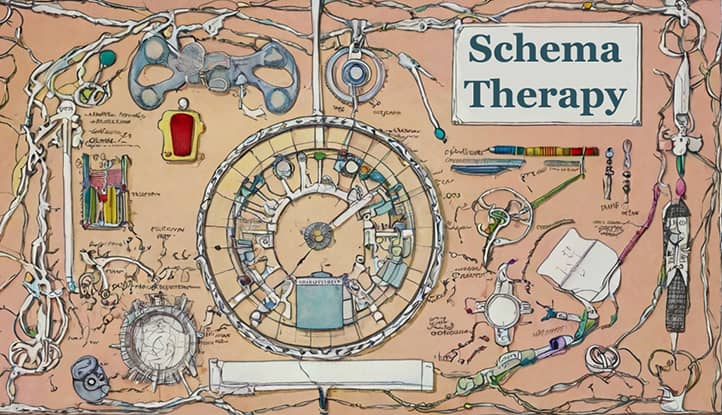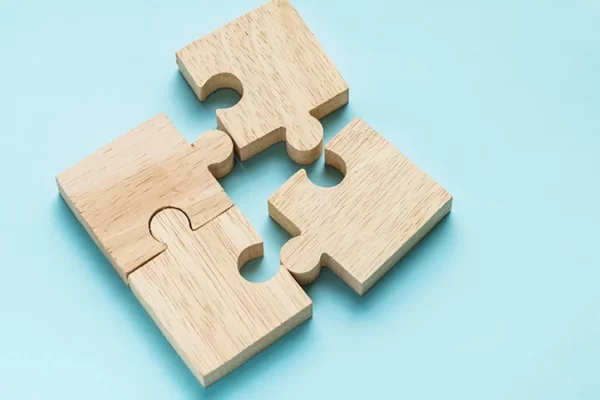Each of us strives for happiness and a fulfilling life. However, on this journey, obstacles often arise that prevent us from achieving what we desire. These obstacles can be both external and internal. And while we are usually prepared to fight external barriers, internal obstacles often go unnoticed, continuing to affect our behavior and emotions.
Schema therapy is an innovative approach in psychotherapy that helps identify and overcome deep-seated patterns of thinking and behavior that prevent us from living a full life. In this article, I’ll explain how schema therapy helps dismantle barriers on the path to happiness and self-fulfillment.
Schema therapy was developed by American psychologist Jeffrey Young in the 1990s. Young, a student and follower of Aaron Beck, the founder of cognitive behavioral therapy (CBT), noticed that traditional CBT was not producing the desired results for some patients with chronic psychological issues.
In studying the reasons for this, Young concluded that such patients have deep-seated patterns of thinking and behavior, which he termed “schemas.” These schemas form during childhood or adolescence and continue to impact an adult’s life, often leading to recurring problems in relationships, career, and other areas.
To work with these deep-rooted schemas, Young integrated elements from various psychotherapeutic approaches, including cognitive-behavioral therapy, psychoanalysis, gestalt therapy, and attachment theory. This resulted in schema therapy—a comprehensive approach aimed at identifying and changing maladaptive schemas.
Schema therapy is based on several key principles:
- Early Maladaptive Schemas: These are enduring patterns of thinking and behavior formed during childhood or adolescence as a result of unmet basic emotional needs.
- Schema Modes: These are current emotional states and coping mechanisms activated in specific situations and linked to particular schemas.
- Basic Emotional Needs: Schema therapy identifies five basic needs: secure attachment, autonomy and a sense of identity, freedom to express emotions and needs, spontaneity and play, realistic limits.
- Integration of Various Therapeutic Approaches: Schema therapy uses cognitive, behavioral, emotionally-focused, and experiential techniques.
- Therapeutic Relationship: Special attention is paid to the relationship between therapist and client, which serves as a model for healthy relationships and helps to “re-educate” early maladaptive schemas.

Barriers to Happiness
The path to happiness often resembles a maze filled with unexpected twists and dead ends. We strive for joy and fulfillment, but at times it seems that an invisible force holds us back, preventing us from moving forward. This force is our inner barriers, formed through years of experience, often painful and traumatic.
Like the roots of an ancient tree, these barriers penetrate deeply into our psyche, nourished by fears, doubts, and negative beliefs. They can manifest as self-sabotage, fear of intimacy, or a constant sense of inadequacy. Often, we aren’t even aware of their existence, attributing our failures to external circumstances or “bad luck.”
However, it’s important to learn to recognize and explore these inner barriers. This process requires courage and patience, but it is essential for freeing ourselves from self-imposed limitations and opening the path to true happiness and self-fulfillment.
Defining “Schema” in Therapy Context
In the context of schema therapy, a schema is a persistent pattern or template formed in childhood or adolescence and developed throughout life. Schemas include memories, emotions, cognitions, and bodily sensations. They determine how a person perceives themselves, others, and the world.
Schemas act as filters through which we interpret the events of our lives. They affect our thoughts, feelings, and behaviors, often leading to repeating patterns in relationships and other areas of life.
Examples of Common Maladaptive Schemas
Jeffrey Young, the founder of schema therapy, identified 18 early maladaptive schemas, which he grouped into five domains. Here is a brief description of each schema:
Domain of Disconnection and Rejection
1. Abandonment/Instability: The belief that significant others will not provide necessary support and connection.
2. Mistrust/Abuse: The expectation that others will inflict harm, humiliate, deceive, or manipulate.
3. Emotional Deprivation: The belief that one’s emotional needs will not be adequately met by others.
4. Defectiveness/Shame: The feeling that one is defective, bad, undesirable, or inadequate in important ways.
5. Social Isolation/Alienation: The feeling of being isolated from the rest of the world, different from others.
Domain of Impaired Autonomy and Performance
6. Dependence/Incompetence: The belief that one is unable to handle everyday responsibilities independently.
7. Vulnerability to Harm or Illness: An exaggerated fear that a catastrophe could happen at any moment.
8. Enmeshment/Undeveloped Self: Excessive emotional involvement and closeness with one or more significant others at the expense of full individuation.
9. Failure: The belief that one is bound to fail or that one’s achievements are insignificant compared to others.
Domain of Impaired Limits
10. Entitlement/Grandiosity: The belief that one is superior to others, has special rights and privileges.
11. Insufficient Self-Control/Self-Discipline: Difficulty exercising self-control and tolerating frustration when pursuing goals.
Domain of Other-Directedness
12. Subjugation: Excessive yielding to the control of others due to a sense of coercion.
13. Self-Sacrifice: Excessive focus on meeting the needs of others at the expense of one’s own needs.
14. Approval-Seeking/Recognition-Seeking: Excessive emphasis on gaining approval, recognition, or attention from others.
Domain of Over-vigilance and Inhibition
15. Negativity/Pessimism: Persistent focus on the negative aspects of life while minimizing the positive.
16. Emotional Inhibition: Excessive suppression of spontaneous actions, feelings, or communication.
17. Unrelenting Standards/Hyper-Criticism: The belief that one must adhere to very high internalized standards of behavior and performance.
18. Punitiveness: The belief that people should be harshly punished for their mistakes.
Understanding these schemas is a key step in schema therapy, as it helps identify the core patterns of thinking and behavior that may hinder achieving happiness and a fulfilling life.

How Schema Therapy Helps Dismantle Barriers
Imagine your mind as an old house full of rooms with locked doors. Behind each door lie memories, emotions, and beliefs that shape your personality. Schema therapy is the key that helps unlock these doors, allowing you to explore the contents of each room and make repairs as needed.
This approach is akin to an archaeological excavation of your inner world. Layer by layer, schema therapy helps reveal deep-seated patterns that affect your thoughts, feelings, and behaviors. Just as an archaeologist carefully cleans an ancient artifact, the therapist helps you cautiously explore your schemas, understanding their origins and impact on your life.
But schema therapy isn’t just about excavating the past. It also provides tools for building a new, healthier future. Like an architect designing a new building, schema therapy helps you design and construct new, more adaptive ways of thinking and behaving that better serve your current needs and goals.
Identifying and Acknowledging Personal Schemas
The first step in overcoming the barriers created by maladaptive schemas is to identify and acknowledge them. Schema therapy offers various methods to achieve this:
- Questionnaires and Surveys: Specially designed psychological tests help identify prevalent schemas.
- Life History Analysis: The therapist and client explore key life events that may have led to the formation of specific schemas.
- Exploring Current Problems: Analyzing recurring problems in the client’s life can point to underlying schemas.
- Visualization Techniques: Clients are encouraged to imagine challenging situations from the past or present, which helps to reveal activated schemas.
Techniques for Working with Maladaptive Schemas
After identifying schemas, schema therapy offers several techniques for changing them:
- Cognitive Restructuring: Identifying and changing negative automatic thoughts associated with schemas.
- Emotionally-Focused Techniques: Working with emotions related to schemas, including the “chair dialogue” technique and imagery techniques.
- Behavioral Experiments: Gradual changes in behavior that reinforce schemas.
- Therapeutic Relationship: Using the relationship between therapist and client to eliminate early maladaptive schemas.
Developing Healthy Ways of Thinking and Behaving
The ultimate goal of schema therapy is not just to eliminate maladaptive schemas but to develop healthy alternatives. This includes:
- Forming Adaptive Schemas: Developing new, healthy beliefs about oneself, others, and the world.
- Improving Emotional Regulation: Learning techniques for self-regulating emotional states and managing stress.
- Developing Interpersonal Skills: Enhancing the ability to establish and maintain healthy relationships.
- Boosting Self-Esteem and Self-Acceptance: Working on building a more positive and realistic self-image.

The Main Methods of Schema Therapy
Schema therapy is like a multi-functional tool, with each function aimed at working with different aspects of our psyche. Just as a sculptor uses various chisels to create a masterpiece, a schema therapist employs diverse techniques to help a client transform their internal reality.
These methods can be compared to various lenses through which we view our life. Cognitive techniques allow us to see distortions in our thinking, emotionally-focused methods help us process and heal deep emotional experiences, and behavioral techniques give us a chance to try new ways of interacting with the world.
The combination of these methods creates a kaleidoscopic effect, where each turn reveals a new pattern of understanding ourselves and our relationships with others. It is not merely a set of techniques but a holistic approach to healing and growth, touching every aspect of our being – from thoughts and feelings to behaviors and relationships.
Cognitive Techniques
Cognitive techniques in schema therapy aim to modify dysfunctional thoughts and beliefs associated with early maladaptive schemas. These techniques include:
- Identifying and challenging automatic thoughts: Clients learn to recognize negative automatic thoughts and assess their validity.
- Pros and cons analysis: Considering the advantages and disadvantages of maintaining or changing a particular schema.
- Schema map creation: A visual representation of the connections between the schema, triggers, thoughts, emotions, and behavior.
- Developing new, healthy beliefs: Creating and reinforcing alternative, more adaptive beliefs.
- Schema dialogue: A technique in which the client learns to have an internal dialogue to challenge their maladaptive schemas.
Emotionally-Focused Techniques
Emotionally-focused techniques play a key role in schema therapy, as many schemas have deep emotional roots. These techniques include:
- Chair dialogues: The client engages in dialogue between different parts of themselves, represented by different chairs. For example, a dialogue between the “vulnerable child” and the “critical parent.”
- Imagery techniques: Using imagination to create and modify images related to schemas, such as envisioning oneself in childhood and “reparenting” that image.
- Emotional letters: Writing letters to significant people (without sending them) to express suppressed emotions.
- Body-oriented techniques: Working with physical sensations connected to emotions and schemas.
- Mindfulness techniques: Practices that help clients stay in the present moment and observe their thoughts and feelings without judgment.
Behavioral Techniques
Behavioral techniques in schema therapy are aimed at changing behavior patterns that sustain maladaptive schemas. These include:
- Behavioral experiments: Planning and engaging in actions that test the validity of schemas in real-life situations.
- Role-playing: Practicing new behaviors in the safe environment of therapy.
- Gradual exposure: Gradually facing anxiety-provoking situations to overcome avoidant behavior.
- Skills training: Developing specific skills, such as assertiveness or anger management.
- Homework assignments: Practicing new skills and behaviors between sessions.

Practical Application of Schema Therapy
Schema therapy is not just a theoretical concept; it is a practical tool for everyday life. Just as we learn a new language by practicing it every day, so too do the skills acquired in schema therapy require consistent application and refinement in real-life situations.
Imagine learning to play a musical instrument. You will not become a virtuoso by merely reading music textbooks – you need to practice every day. Similarly, working with schemas requires regular practice and patience. Every situation in your life becomes an opportunity for learning and personal growth, a chance to apply new, healthier ways of thinking and behaving.
However, unlike learning music, where you can practice alone, schema therapy involves the vital support of a psychotherapist who not only teaches techniques but also provides a safe space for exploration and practice. This collaboration creates a unique environment to experiment with new ways of being, gradually integrating them into daily life.
Examples of Exercises and Techniques for Self-Practice
While schema therapy is typically conducted under the guidance of a qualified therapist, some exercises can be practiced independently:
- Schema journal: Record situations that elicit strong emotional reactions and try to identify which schemas may have been activated.
- The “Caring Parent” technique: Imagine an ideal, caring parent and try to speak to yourself from their perspective, especially in challenging situations.
- Safe place visualization: Create an image of a place where you feel completely safe and calm. Return to this image in stressful situations.
- Mindfulness practice: Spend a few minutes each day simply observing your thoughts and feelings without judgment.
- Schema letter: Write a letter to one of your schemas, expressing everything you feel towards it.
- Pros and cons analysis: Make a list of the advantages and disadvantages of a particular schema or related behavior.
- “Mature Adult” technique: In difficult situations, ask yourself, “How would a mature adult handle this?”
Remember, these exercises do not replace professional psychotherapy but can be a helpful addition to working with a psychologist.
The Role of the Therapist in Schema Therapy
The therapist plays a key role in schema therapy, fulfilling several important functions:
- Diagnosis and assessment: The therapist helps identify the client’s key schemas and modes using special questionnaires, observation, and life history analysis.
- Creating a safe environment: The therapist provides an atmosphere of acceptance and support, which is especially important for clients with traumatic experiences.
- Education and psychoeducation: The therapist explains schema therapy concepts and helps the client understand how schemas affect their life.
- Modeling healthy relationships: Through the therapeutic relationship, the client experiences healthy, supportive relationships, helping change early maladaptive schemas.
- Guiding the process: The therapist directs the therapy process, choosing appropriate techniques and setting the pace of work.
- Emotional support: The therapist offers emotional support, especially when the client confronts painful memories or emotions.
- Feedback: The therapist provides constructive feedback, helping the client see their blind spots and behavior patterns.

Advantages of Schema Therapy
Schema therapy is like a deep dive into the ocean of our psyche. While many other therapeutic approaches merely skim the surface, schema therapy allows us to explore the depths of our inner world, where the roots of our problems and the keys to their resolution lie.
This approach can be likened to restoring an ecosystem. Instead of fighting individual symptoms, schema therapy aims to restore balance to the entire system. It not only removes the weeds of negative thoughts and behaviors but also enriches the soil of our psyche, creating favorable conditions for the growth of healthy patterns.
One of the unique advantages of schema therapy is its ability to create lasting change. Just as changing the course of a river alters the entire landscape, so too does working with deep schemas transform our entire lives. This is not a quick fix but a fundamental transformation that continues to bear fruit long after therapy ends.
Effectiveness in Treating Various Psychological Issues
Schema therapy has proven effective in treating a wide range of psychological issues:
- Personality disorders: Especially effective in treating borderline personality disorder, for which it was originally developed.
- Chronic depression: Helps identify and change deep-rooted beliefs that sustain depressive states.
- Anxiety disorders: Effective in addressing deep-seated fears and beliefs underlying anxiety.
- Eating disorders: Helps address key schemas related to self-esteem and control.
- Relationship issues: Enables identification and modification of patterns that hinder healthy relationships.
- Post-traumatic stress disorder (PTSD): Helps process traumatic experiences and change associated beliefs.
- Addictions: Effective in addressing the deep-seated causes of addictive behavior.
Research shows that schema therapy is especially useful for clients with chronic, treatment-resistant issues who have not seen significant improvement from other types of therapy.
Long-Term Results and Relapse Prevention
One of the main benefits of schema therapy is its ability to provide long-term results and prevent relapses. This is facilitated by the following factors:
- Addressing root causes: Rather than focusing on symptoms, schema therapy addresses the underlying causes of problems, reducing the likelihood of their return.
- Developing self-awareness: Clients learn to better understand their emotional reactions and behavior, enabling them to cope more effectively with future difficulties.
- Forming new, healthy patterns: Schema therapy helps not only eliminate negative patterns but also establish new, more adaptive ways of thinking and behaving.
- Improving emotional regulation skills: Clients learn to manage their emotions better, reducing the risk of emotional breakdowns and relapses.
- Changing core beliefs: Working to change deep-rooted beliefs about oneself and the world creates a more stable foundation for psychological well-being.
- Developing the “Mature Adult”: Clients learn to activate and strengthen their “mature adult” part, which can handle life’s challenges more effectively.
- Enhancing interpersonal relationships: Changing maladaptive relationship patterns leads to more stable and fulfilling connections, an important factor in psychological health.

Conclusion
Schema therapy is a powerful tool for those ready to embark on a journey of self-discovery and personal growth. It opens the door to understanding the deep patterns that shape our reality and provides the means to transform them.
This therapeutic approach is unique in that it does not merely treat symptoms but addresses the roots of issues. By working with early maladaptive schemas, we gain the opportunity to rewrite our life story, replacing limiting beliefs with healthier, more adaptive ones.
The benefits of schema therapy extend far beyond the therapist’s office. It provides tools for ongoing self-analysis and growth that can be used throughout life. By developing the “mature adult” within ourselves, we learn to cope more effectively with life’s challenges and build more fulfilling relationships.
However, it is essential to remember that schema therapy is not a magic pill but a path requiring time, effort, and patience. It is a process of exploration, understanding, and gradual transformation of deeply ingrained patterns. But the results of this work can be truly transformative, opening the way to a more authentic, fulfilling, and joyful life.
If you find yourself repeatedly facing the same problems, if you feel like something inside is holding you back from achieving what you want, it may be time to consider schema therapy as a path to change. Start by learning about schema therapy concepts, try some self-help techniques, and if you feel ready for deeper work, seek out a qualified schema therapist.




